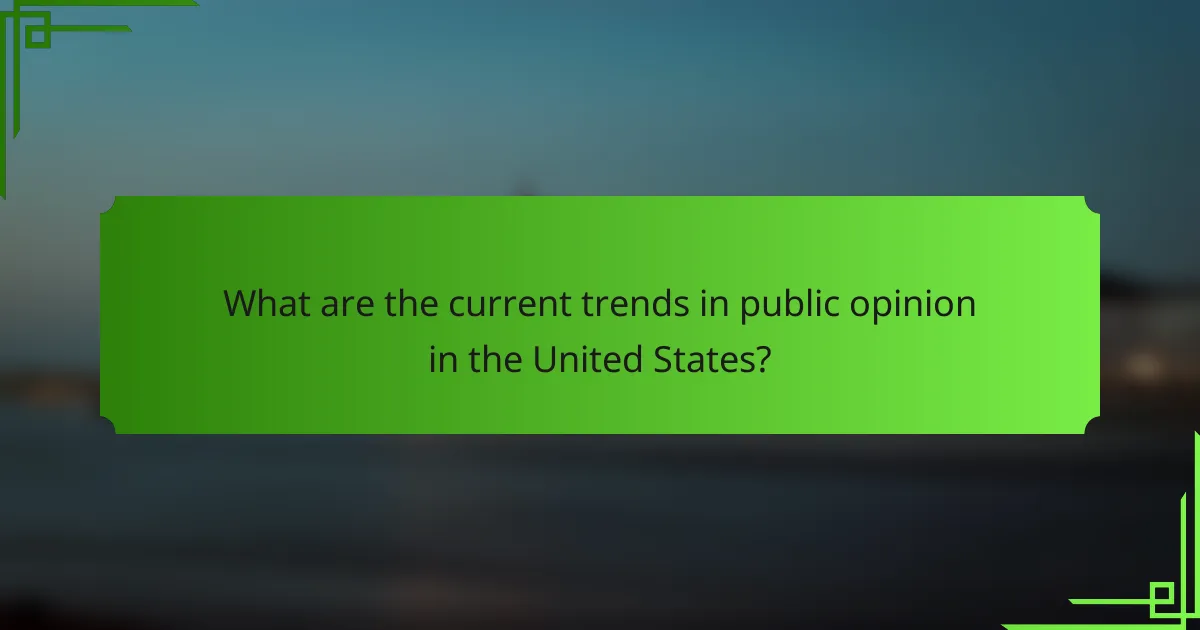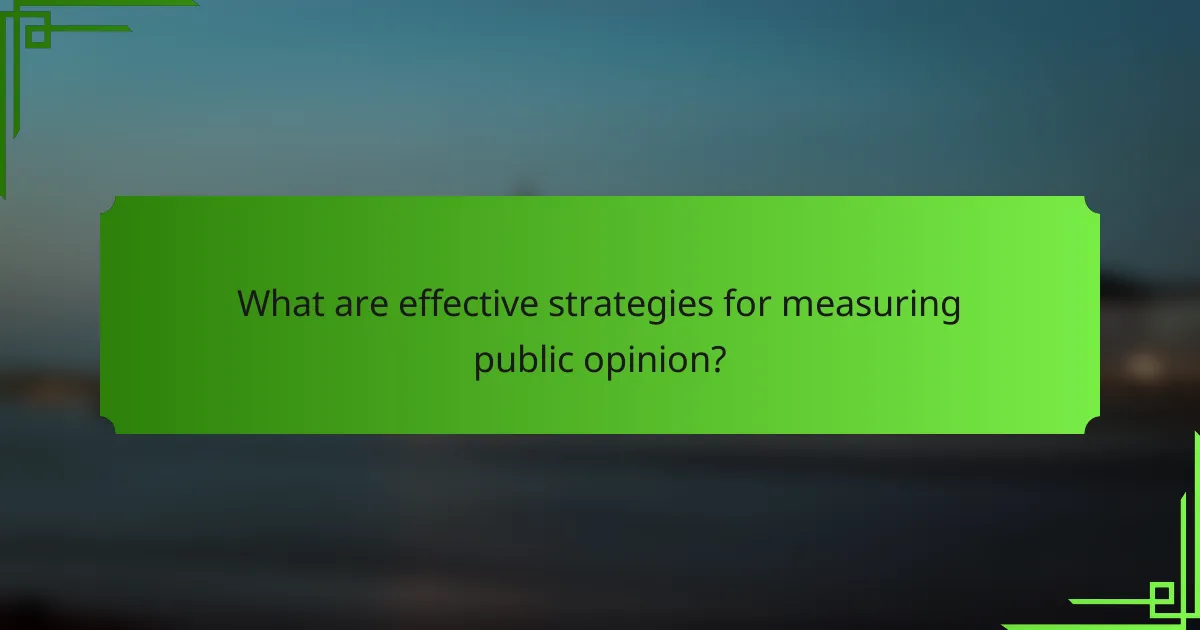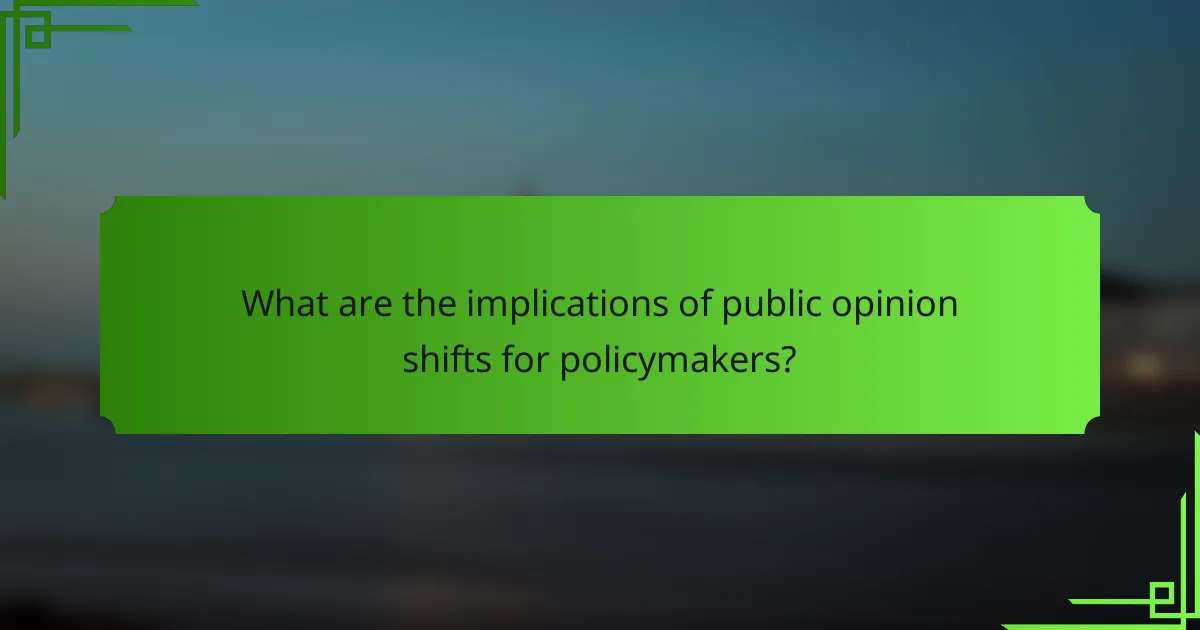Public opinion in the United States is undergoing notable transformations, characterized by increasing polarization and the pervasive influence of social media. These shifts are not only reshaping political discourse but also affecting voter demographics and electoral outcomes. Additionally, parapolitical issues play a crucial role in shaping perceptions of legitimacy and trust in political systems, further complicating the landscape of public sentiment.

What are the current trends in public opinion in the United States?
Current trends in public opinion in the United States indicate a significant increase in polarization, a growing influence of social media, and notable shifts in voter demographics. These trends are shaping political discourse and impacting electoral outcomes across the country.
Increased polarization
Increased polarization refers to the widening ideological divide between political parties and their supporters. This trend has led to more extreme views and less willingness to compromise on key issues, resulting in heightened tensions in political discussions.
For example, surveys show that individuals identify more strongly with their party affiliations than in previous decades, often viewing opposing party members as adversaries rather than fellow citizens. This polarization can affect everything from legislative processes to community interactions.
Rise of social media influence
The rise of social media has transformed how public opinion is formed and expressed. Platforms like Twitter and Facebook allow for rapid dissemination of information, but they also contribute to echo chambers where users are exposed primarily to viewpoints that reinforce their own beliefs.
This influence can skew perceptions of public sentiment, as trending topics may not accurately reflect the broader population’s views. Additionally, misinformation can spread quickly, complicating efforts to gauge true public opinion on critical issues.
Shifts in voter demographics
Shifts in voter demographics are reshaping the political landscape in the United States. Factors such as age, race, and educational attainment are influencing voting patterns, with younger and more diverse voters increasingly participating in elections.
For instance, recent elections have seen higher turnout rates among minority groups and younger voters, which can significantly impact election outcomes. Political campaigns must adapt to these demographic changes by addressing the specific concerns and values of these emerging voter blocs.

How do parapolitical issues affect public opinion?
Parapolitical issues significantly shape public opinion by influencing perceptions of legitimacy and trust in political systems. These issues often arise from the intersection of politics and social movements, affecting how individuals view government actions and policies.
Impact of misinformation
Misinformation can distort public understanding of parapolitical issues, leading to polarized opinions and confusion. For example, false narratives about political events can spread rapidly through social media, creating a misinformed electorate that may support extreme positions.
To combat misinformation, it is crucial for individuals to verify sources and seek information from reputable outlets. Engaging in critical thinking and discussing topics with diverse groups can also help mitigate the effects of misleading information.
Role of political activism
Political activism plays a vital role in shaping public opinion by mobilizing communities around parapolitical issues. Activist movements can bring attention to specific concerns, influencing how people perceive government actions and policies.
Effective activism often involves grassroots organizing, social media campaigns, and public demonstrations. By fostering dialogue and raising awareness, activists can shift public sentiment and encourage civic engagement, ultimately affecting policy decisions and political discourse.

What are effective strategies for measuring public opinion?
Effective strategies for measuring public opinion include utilizing surveys, focus groups, and social media analytics. Each method offers unique insights and can be tailored to specific demographics or issues, helping to gauge public sentiment accurately.
Surveys and polls
Surveys and polls are structured questionnaires designed to collect data on public attitudes and opinions. They can be conducted via telephone, online platforms, or in-person, and typically include a mix of closed and open-ended questions to capture quantitative and qualitative data.
When designing surveys, consider factors such as sample size, question wording, and distribution methods. A well-constructed survey can yield insights into public preferences, with response rates often ranging from 5% to 30%, depending on the approach used.
Focus groups
Focus groups involve small, diverse groups of participants discussing specific topics guided by a moderator. This qualitative method allows for in-depth exploration of opinions, motivations, and feelings, providing richer context than surveys alone.
When organizing focus groups, aim for 6 to 10 participants to ensure a manageable discussion. It’s crucial to select participants who represent the target demographic, as this enhances the relevance of the insights gathered.
Social media analytics
Social media analytics involves monitoring and analyzing user-generated content on platforms like Twitter, Facebook, and Instagram to gauge public sentiment. This method can reveal trends and shifts in opinion in real-time, making it a valuable tool for understanding current public discourse.
To effectively use social media analytics, track engagement metrics such as likes, shares, and comments, and utilize sentiment analysis tools to interpret the emotional tone of the content. Be aware that social media opinions may not represent the broader population, as users tend to be younger and more tech-savvy.

How can businesses respond to shifts in public opinion?
Businesses can effectively respond to shifts in public opinion by adapting their strategies and engaging with their stakeholders. This involves understanding the changing sentiments of the public and aligning business practices with these views to maintain relevance and trust.
Adjust marketing strategies
To adjust marketing strategies, businesses should first conduct thorough research to understand current public sentiments and preferences. This can involve analyzing social media trends, customer feedback, and market reports to identify key shifts.
Once insights are gathered, companies can tailor their messaging and campaigns to resonate with the evolving opinions of their target audience. For example, if there is a growing demand for sustainability, marketing materials should highlight eco-friendly practices and products.
Engage in corporate social responsibility
Engaging in corporate social responsibility (CSR) is crucial for businesses looking to align with public opinion. Companies should identify social issues that matter to their stakeholders and actively contribute to these causes, whether through donations, volunteer programs, or partnerships with non-profits.
For instance, a business might implement initiatives that support local communities or promote diversity and inclusion. By demonstrating a commitment to social values, companies can enhance their reputation and build stronger connections with consumers.

What are the implications of public opinion shifts for policymakers?
Shifts in public opinion can significantly influence policymakers by prompting changes in legislation, funding priorities, and overall governance strategies. Understanding these implications is crucial for effective decision-making and maintaining public trust.
Policy adjustments
Policymakers often adjust their strategies in response to changing public sentiment. For instance, if a majority of citizens express concern about climate change, governments may prioritize environmental policies and renewable energy investments. These adjustments can range from minor tweaks in existing laws to the introduction of entirely new regulations.
To effectively respond to public opinion, policymakers should regularly conduct surveys and engage with constituents. This proactive approach helps identify emerging trends and allows for timely policy adaptations that align with the electorate’s needs.
Increased transparency
As public opinion evolves, there is a growing demand for transparency in government actions. Citizens expect clear communication regarding policy decisions and the rationale behind them. Increased transparency can foster trust and accountability, making it essential for policymakers to openly share information about their processes and outcomes.
Implementing transparency measures can include publishing detailed reports, hosting public forums, or utilizing digital platforms for real-time updates. By doing so, policymakers can better align their actions with public expectations and mitigate skepticism about their intentions.

What frameworks exist for analyzing public opinion data?
Frameworks for analyzing public opinion data include both quantitative and qualitative methods. These approaches help researchers understand trends, shifts, and the underlying sentiments of a population.
Quantitative analysis methods
Quantitative analysis methods involve numerical data collection and statistical techniques to interpret public opinion. Surveys and polls are common tools, often employing structured questionnaires to gather responses from a representative sample.
Key considerations include sample size, which should typically be in the low hundreds to low thousands for reliable results, and question design, which must avoid leading or biased phrasing. Tools like regression analysis can help identify correlations between variables.
Common pitfalls include overgeneralizing results from a small sample or failing to account for demographic differences. Always ensure that the data collection adheres to ethical standards and respects participants’ privacy.
Qualitative research approaches
Qualitative research approaches focus on understanding the deeper meanings and motivations behind public opinion. Techniques such as focus groups, in-depth interviews, and open-ended survey questions allow for rich, detailed insights.
When using qualitative methods, consider the importance of participant selection to ensure diverse perspectives. Analyzing the data often involves thematic coding, which helps identify recurring patterns and sentiments.
Do not overlook the subjective nature of qualitative data, as it can be influenced by researcher bias. Triangulating findings with quantitative data can enhance credibility and provide a more comprehensive view of public opinion.

How do cultural factors influence public opinion?
Cultural factors significantly shape public opinion by affecting how individuals perceive issues and form attitudes. Elements such as traditions, values, and social norms play a critical role in determining collective viewpoints within different communities.
Regional differences
Regional differences can greatly impact public opinion due to varying cultural backgrounds and local customs. For instance, urban areas may prioritize progressive policies, while rural regions might lean towards traditional values. This divergence often results in contrasting opinions on issues like climate change, healthcare, and education.
Understanding these regional nuances is essential for policymakers and marketers alike. Tailoring messages to resonate with local cultural contexts can enhance engagement and acceptance of initiatives or products.
Socioeconomic status
Socioeconomic status influences public opinion by affecting access to information and resources. Individuals from higher socioeconomic backgrounds may have different priorities and perspectives compared to those from lower-income groups. For example, wealthier individuals might focus on tax policies that favor investment, while lower-income populations may prioritize social welfare programs.
Awareness of these disparities is crucial for effective communication. Engaging with diverse socioeconomic groups requires recognizing their unique concerns and addressing them in a manner that reflects their lived experiences and challenges.
